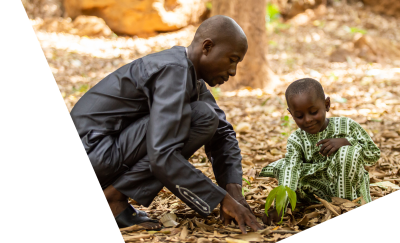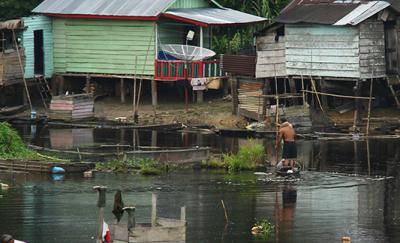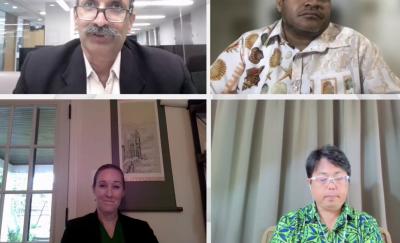It might be the most important government-issued manual on Earth. Fiji, with more than 300 islands and a population of about 1 million, developed a manual for relocating communities that will be under water due to rising sea levels—a devastating result of climate change.
Six villages already have moved, and Fiji plans to move dozens more over the next decade. The government must acquire land and build schools, homes, churches, and health centers. It must extend drinking water, electricity, roads, and other infrastructure to make the new places livable. Authorities must move burial grounds with great care. All of this is a gargantuan financial, political, and soul-wrenching undertaking.
“The slow onset nature of climate change possibly has the deepest long-term scar,” says Satyendra Prasad, Abt Global’s principal technical lead for climate and localization, who was born in Fiji and lived through rising waters and ruinous storms. “When buildings are destroyed, you can rebuild buildings, it's expensive, it's painful, but when whole lands are lost to the sea, there's very little options left. And this is the stark reality of much of the Pacific Islands, including Fiji.”
Indeed, Fiji isn’t alone. Two thousand kilometers away, at least five vegetated reef islands that were part of the Solomon Islands already have disappeared. Both countries are part of the Blue Pacific, a concept that views the group of island states in the Pacific and the adjacent waters they control as arguably the largest continent on the planet. It’s an oceanic rather than land continent that binds together the islands through their shared geography, languages, traditions, and challenges. It also highlights the biodiversity and ecosystems that are central to--and critical for--the islands’ Indigenous populations.
The nations in the Blue Pacific account for half of the 39 Small Island Developing States (SIDS), which comprise more than 1,000 islands from Antigua to Vanuatu and a population of 65 million. These island nations control marine areas that are, on average, 28 times the size of their land mass and 16.1 percent of the world’s exclusive economic zones. They are large ocean states rather than small island states and have immense climate potential. In fact, the carbon-dioxide absorbing oceans in their jurisdictions offer the world one of its best climate-change fighting tools.

For the Blue Pacific, the financial burden of coping with recurring climate change-fueled disasters—borrow, rebuild, repeat—is untenable. The economic drain makes it tough to realize sustainable development or global climate commitments, including Nationally Determined Contributions (NDCs) and National Adaptation Plan (NAP) development under the Paris Agreement on climate.
Yet mitigating the effects of climate change on the marine environment is critical for these nations—and indeed for the planet. Oceans are major repositories of biodiversity, home to more than a quarter million known species. Warmer waters disrupt the delicate balance of marine ecosystems. Ocean acidification degrades coral habitats and weakens food chains. And sea level rise destroys crucial resources such as carbon-absorbing mangroves.
The degradation of the marine ecosystem can have a profound economic impact on the Blue Pacific. The average elevation of the Pacific island nations is about three to seven feet above sea level, with 90 percent of the population living within three miles of the coast and about half of all infrastructure less than half a mile from the sea.
In 2008, surging waters inundated a number of Micronesian atolls, wrecking freshwater supplies and destroying agriculture on about 60 percent of the inhabited islands. Continued rises in ocean levels will increase the risks to infrastructure, freshwater supplies, agriculture, livelihoods, food supplies, and habitats for threatened and endangered species. Tourism, vital to the economies of some of these tropical jewels, is particularly problematic. It is both a driver of climate change and more vulnerable than the rest of the economy to its effects.
The plight of the Blue Pacific is a harbinger of similar perils to come on a much larger scale. Land currently home to as many as 480 million people could be flooded by the end of the century, forcing relocation. “This is something that the world is not prepared for,” says Dr. Prasad.
Oceans and Other Nature-Based Climate Solutions
While rising oceans pose a threat, they also offer a solution. Oceans serve as an enormous carbon sink, absorbing 30 percent of the carbon dioxide emissions released into the atmosphere.
Ocean-based action can close the global emissions gap by as much as 35 percent based on solutions that are ready to implement. Although scores of Nationally Determined Contributions (NDCs) under the Paris Agreement have a blue component, the combined level of GHG reductions from them is nowhere close to realizing this potential.
“All NDCs will need to enhance their blue component,” Dr. Prasad says. “Many countries will need significant support to raise the blue bar in their NDCs. This does not include only ocean-based components, but also rivers, lakes, and marshlands.” Mangroves and coastal wetlands, for example, offer the most efficient nature-based solutions in the world, sequestering 10 times more carbon than mature tropical forests.
Forests are still crucial, absorbing as much as 25 percent of carbon emissions each year. A billion additional hectares of forest could double that amount through 2050 without harming food security. But floods, pest outbreaks, wildfires, and droughts release some of the 1200 gigatons of carbon in forest carbon reservoirs. That’s why protecting and expanding forests are so critical.
Grasslands and pastures absorb carbon and provide biodiversity and ecosystem services that can produce more resilient agriculture. Potential climate solutions include conservation agriculture, integration of trees, agroforestry, silvopasture, and restoration of degraded lands. Farmers must transition from pesticides and other chemical inputs to biopesticides, manure, and organic fertilizer while maintaining soil health and yield.
Other options include improving the relationship among ecosystem functions such as pollination, water provisioning, soil fertility, and pest management; restoring habitats crucial to watershed health to protect farmland and homes; and recycling waste in coastal towns and cities instead of discharging waste into the water.
While protecting and restoring coastal wetlands—mangrove forests, tidal salt marshes, and seagrass meadows—will help realize carbon emission reductions, these activities generate additional important benefits. They include better water quality, increased fishery production, improved livelihoods through tourism and other coastal jobs, and protection of coastlines from storm surges, floods, and erosion.
The Front Line of Rising Sea Levels
The majority Indigenous populations of the island states of the Blue Pacific can play a critical leadership role in protecting oceans. Having faced the challenge of rising sea levels for decades, the Blue Pacific has the experience—and need—to pioneer adoption of climate-smart approaches for their economic sectors from agriculture to fisheries. They can provide leadership in incorporating Indigenous communities’ traditional knowledge to design, develop, and implement interventions for everything from preparedness and disaster response to adaptation. A challenge noted in a study by Shankar Aswani of Rhodes University in The Journal of the Polynesian Society (see box) is that Western practices decrease islanders’ traditional capacity to detect, comprehend, and respond to ecological changes. That undermines resilience and exacerbates vulnerability. Fortunately, that’s changing.
The Blue Pacific’s Long History of Climate Advocacy
In the 1980s when Dr. Prasad and other young scholars from the Blue Pacific started to speak out about the climate challenges they faced, they found themselves on the margins of global discussions.
They concluded that Western narratives about the Blue Pacific suggested these distant microstates simply didn’t matter. Now, though, through international climate and ocean advocacy, the Blue Pacific is reclaiming its history and slowly but surely reshaping a more sustainable narrative for its future—and the world’s.
The innovative notion of a vast Blue Pacific flipped the historical narrative. And it enabled those nations, which faced repeated catastrophes, to bring evidence and data to the table and elevate the centrality of climate change into the global development discourse.
Today, the world is rallying around the goal of keeping temperatures from rising more than 1.5 degrees Celsius. The target is the product of discussions starting in the early 2010s in the lead up to what would be the Paris Agreement in 2015. A coalition of Blue Pacific countries offered the target as a crucial compromise. It enabled large economies to agree to what they considered a realistic and achievable target. But it was a compromise for SIDS because even at that level, they would stand to lose between 40 to 60 percent of their land-based economies. The compromise strategy worked, with both sides agreeing to that goal in Paris. At COP28 in 2023, the Blue Pacific continued its advocacy for sustainable oceans to mitigate climate change in a session Dr. Prasad moderated to launch the #AcceleratingBlueActionForClimate initiative.
Investments Needed in the Blue Economy
It’s critical to increase the level of investments in the Blue Economy: the development, preservation, and regeneration of the marine environment. But what’s ultimately needed is a shift toward environmentally friendly activities and away from the use of oceans and seas for unsustainable forms of commercial fisheries, mega-coastal resort developments, and other harmful extraction activities. Food systems also must reduce their carbon footprint more rapidly.
“The world’s shipping will need to decarbonize much sooner than thought earlier,” Dr. Prasad says. “The world will need green shipping corridors across the busy sea lanes.” He adds that “these will require multi-country agreements and for governments, industry, and communities to work together.”
Any Blue Economy development needs to integrate a range of disciplines, from traditional and Indigenous knowledge to big data. When science or meteorological measurement may be scarce, Indigenous communities with intimate knowledge of their land and ecosystem can lead in co-creating informed, meaningful, and sustainable measures. Traditional fishing approaches, which consider the health of the oceans and not just the market value of what’s caught, can help preserve a sustainable ecosystem.
Re-adjusting one’s lens on the oceans uncovers blue opportunities in nearly every sector, from solid waste management and plastics to refashioning coastal livelihoods by protecting marine biodiversity in sensitive regions. Tourism, for instance, needs to transition to enable net zero or climate positive vacations. Protecting aquatic carbon sinks requires advancements in voluntary carbon markets. And regenerating coastal habitats can be critical to mitigating the climate crisis since their role in carbon sequestration looms so large.
Financing Climate Action: Models from the Pacific and Beyond
Given the scale of the need, innovative financing is crucial. The private sector has been reluctant to get involved for several reasons. “Underinvested sectors and geographies have more nascent and less proven business models, so there's a higher risk for private capital players to invest,” notes Arun Asok, Abt’s senior advisor for private capital and impact investing.
And over 90 percent of impact investment assets are headquartered in the Global North. The firms may have investment teams in emerging markets, but the investment committees that make the decisions are in the Global North headquarters. “This impacts the investment process, especially pipeline sourcing and the ability to make nuanced investment decisions for a specific sector or geography,” Arun says. One solution for mobilizing more capital: blended financing, in which public investors provide first loss or a guarantee or other catalytic capital to reduce risk for private investors.
New schemes are turning that vision into reality for other island and coastal countries. Belize and Seychelles, for example, have issued Blue Bonds to get private sector funds for resilience, sustainability, and jobs in their Blue Economies. These make it simpler for commercial and philanthropic investors to help protect coral reefs and mangroves and to recycle waste in small island states.
In Indonesia, an archipelago country of 17,000 islands, Abt is developing a proposal for the national Blue Halo finance program, announced by the Indonesian Government at its G20 meeting in 2022. The program will use a blended finance approach to combine public and philanthropic capital with private sector investment in ocean conservation, sustainable fisheries, and livelihoods aligned with the United Nations Sustainable Development Goals. This approach establishes a scalable model for sustainable marine management across Indonesia, aligning ecosystem conservation and climate resilience with economic growth. Abt provides technical expertise to develop a Green Climate Fund proposal to finance this initiative. Lessons learned from this model will be highly relevant for a wide array of SIDS.
Another innovation is parametric microinsurance, triggered by weather events. In 2022, the Pacific Insurance and Climate Adaptation Programme launched this in Fiji, Vanuatu, and Tonga, to provide insurance against extreme weather events and offers immediate financial support to populations previously locked out of the insurance market. The parametric solution is offered at relatively low cost and resulted in uptake by vulnerable groups such as women, low-income earners, smallholder farmers, persons with disabilities, social welfare recipients, and micro, small, and medium enterprises.
In the Eastern and Southern Caribbean, Abt leads the Resilient Economies and Sectors Activity (RESET), USAID’s flagship climate resilience program to promote climate finance for sustainable, localized climate solutions in 11 island countries. RESET’s goals include reducing constraints to climate and disaster finance and increasing investments in climate and disaster resilience across economic sectors. It will encourage the private sector to invest in blue and green economies, providing grants that support climate smart technologies and approaches by small businesses.
The project also will collaborate with countries to create their mitigation and adaptation policies. RESET includes women, youth, people with disabilities, and Indigenous groups in the planning, design, and delivery of activities and will enhance the capacity of the 11 countries to increase the number of blended finance projects or deals supporting climate adaptation. It aims to mobilize US$200m for climate change adaptation and help 10,000 people apply climate or disaster smart practices in their businesses and operations.
These initiatives are a start, but governments must accelerate the pace. The Intergovernmental Panel on Climate Change has declared a Code Red. The fires and floods in 2023 make it clear that the panel was right in announcing the alert.
The Blue Pacific and other SIDS countries will be the first to have to tackle on a national basis the challenges of climate change that they surfaced decades ago. They won’t be the last.
Fiji’s manual won’t go out of print any time soon.
How Abt Can Help
Abt Global is systematically responding to these challenges. We work with partners around the world to protect, restore, and sustain the habitats, natural resources, and species that people depend on. Abt works across small island states, large archipelagic states like Indonesia, and countries with large coastlines like Kenya and Mozambique to promote social and economic development through sustainable investments across their blue economies. Our work includes:
- improving solid waste management to protecting mangroves, seagrass, and other aquatic carbon sinks
- supporting advancements in carbon markets
- catalyzing investments in blue finance
- disaster management and recovery
- early warning systems
- preservation of traditional knowledge
- co-benefit analysis
- financial feasibility assessments
- ecosystem services valuation
We tailor our approach to local, environmental, and cultural needs and co-develop solutions with the communities whose intimate knowledge of their land and ecosystem are at the heart of meaningful and sustainable conservation and adaptation measures.
Our competencies in blue financing and ocean accounting help shape innovative financing instruments relevant for different settings. Our skills and expertise in nature-based solutions help create durable partnerships as we work with Indigenous communities. And our global team has collaborated with its networks to become a leading broker, architect, and solutions provider for the sustainable development of blue economies.










